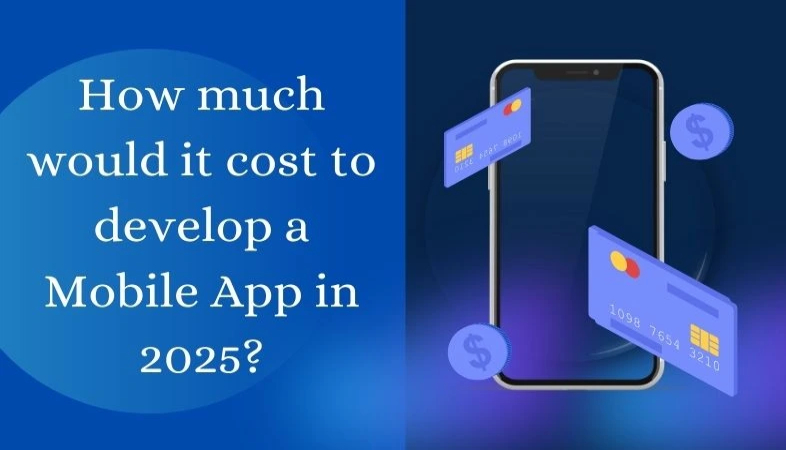
How much would it cost to develop a Mobile App in 2025?

Key Takeaways
- Mobile app development costs in 2025 will vary widely based on factors like app complexity, platform, features, design, and team location.
- Native apps, though costlier, provide superior performance, scalability, and user experience, making them a long-term investment for businesses.
- Cross-platform apps may seem budget-friendly but come with big trade-offs such as lower performance and limited customization options.
- Start with an MVP to minimize initial costs and gather user feedback, and consider leveraging APIs and outsourcing for cost efficiency.
- Post-launch costs like maintenance, updates, and marketing are crucial for your app's long-term success.
The mobile app market continues to thrive as businesses across industries embrace digital transformation. From retail giants launching immersive e-commerce platforms to startups introducing innovative solutions, mobile apps remain a cornerstone of user engagement and revenue generation. If you’re considering building an app, one of the first questions on your mind is likely,“How much would it cost to develop a mobile app in 2025?”
The answer isn’t straightforward. Mobile app development costs vary significantly based on factors such as complexity, platform, features, design requirements, and location of the development team. This blog will break down these factors and provide an estimate to help you plan your project effectively. Whether you're looking for mobile app development in Texas or considering outsourcing, we've got you covered.
Key Factors Influencing Mobile App Development Costs
1. App Complexity
Basic Apps
Basic apps have limited features and straightforward functionality. These could include a simple calculator, note-taking app, or a basic task manager. They are perfect for businesses seeking a quick, low-cost solution without the bells and whistles.
- Development Cost: $10,000 - $20,000
- Timeline: 1-3 months
Mid-Complexity Apps
Apps like social media platforms, fitness trackers, or on-demand delivery services fall into this category. They require more intricate backend systems, databases, and user interfaces but are still manageable within reasonable budgets.
- Development Cost: $25,000 - $60,000
- Timeline: 4-6 months
Complex Apps
Complex apps are feature-rich and often integrate advanced technologies like augmented reality (AR), virtual reality (VR), or artificial intelligence (AI). Examples include apps for real-time gaming or e-commerce platforms with dynamic personalization. Developing such apps requires significant resources and extended timelines.
- Development Cost: $100,000 - $300,000+
- Timeline: 6-12+ months
Here’s a quick look at mobile app development costs based on its complexity:
2. Platforms
Native Apps
Native apps are built specifically for a single platform, such as iOS or Android, using platform-specific languages like Swift for iOS or Kotlin for Android. While they provide superior performance, seamless user experience, and greater access to device features, the costs are higher because separate development teams are needed for each platform. Native apps are ideal for businesses seeking to deliver high-performance solutions tailored to specific platforms.
- Cost: Higher due to dual development requirements.
- Pros: Superior performance, better user experience, full access to device hardware and software features, and greater scalability.
- Cons: Higher cost and longer development time.
Cross-Platform Apps
Cross-platform apps use frameworks like Flutter or React Native to create a single codebase that works on multiple platforms. While these apps are cost-effective and faster to develop, they come with certain limitations. They are suitable for startups or businesses looking for broader reach within a limited budget.
- Cost: Generally lower than native app development.
- Pros: Faster development, lower cost, and a single codebase for multiple platforms.
- Cons: Performance may not match that of native apps, limited access to platform-specific features, and potential compatibility issues with future OS updates.
3. Features and Functionalities
Every additional feature increases the complexity and cost of an app. Below are some common features and their approximate costs:
- User Login: Allowing users to register and log in securely can cost around $2,000 - $4,000.
- Push Notifications: A great way to keep users engaged, push notifications can add $1,500 - $5,000 to your budget.
- In-App Purchases: Monetizing through in-app purchases typically costs between $2,000 - $5,000.
- Geolocation Services: Whether for delivery apps or travel guides, geolocation features can cost $5,000 - $15,000.
- Third-Party Integrations: Features like payment gateways or social media integration often cost $3,000 - $10,000.
- AR/VR Features: High-end features like AR/VR can significantly impact budgets, with costs starting at $20,000.
4. UI/UX Design
The design of your app is critical to its success. A clean, intuitive user interface ensures a positive user experience, encouraging users to stay engaged. The costs depend on whether you choose a basic design or a fully customized user interface.
- Basic Design: Costing $5,000 - $10,000, basic designs include standard layouts and functionality.
- Custom Design: For a unique, branded experience, custom designs range from $10,000 - $50,000+.
5. Development Team Location
Where your development team is located has a substantial impact on the cost of your project. If you’re looking for mobile app development services in Texas, you may find rates on the higher end of the spectrum compared to outsourcing to regions like Eastern Europe or India. Below is a regional cost breakdown:
- North America: $100 - $250/hour
- Western Europe: $80 - $200/hour
- Eastern Europe: $40 - $80/hour
- India/Asia: $25 - $50/hour
6. Post-Launch Costs
Launching your app is just the beginning. Ongoing costs include maintenance, updates, and marketing:
- Maintenance and Updates: Expect to allocate 15-20% of the development cost annually.
- Marketing and User Acquisition: Costs vary widely depending on your target audience and strategy.
- Cloud Hosting and Server Costs: These range from $1,000 - $5,000 per month, depending on user traffic.
Cost Breakdown by App Type
Here’s an estimate of development costs for various app types in 2025:
- E-Commerce Apps: $30,000 - $150,000 These apps include features like a product catalog, payment gateways, inventory management systems, and push notifications. E-commerce apps are especially popular for businesses wanting to expand their digital presence and boost online sales.
- Social Media Apps: $50,000 - $200,000
Social media platforms require robust features like user profiles, newsfeeds, chat systems, and media-sharing capabilities. These apps are designed to handle high traffic and offer interactive user experiences. - On-Demand Delivery Apps: $70,000 - $250,000
These apps are often feature-rich, incorporating real-time tracking, payment gateways, admin dashboards, and review systems. They are ideal for services like food delivery, ride-sharing, or package delivery. - Fitness Apps: $40,000 - $120,000
Fitness apps may include activity tracking, integration with wearable devices, and instructional video content. As health-conscious lifestyles gain traction, these apps continue to attract a wide user base. - Gaming Apps: $100,000 - $500,000+
Gaming apps are among the most complex and costly to develop. They require advanced graphics, multiplayer capabilities, and often in-app purchase mechanisms. These apps cater to a vast global audience and can yield substantial revenue.
Cost-Saving Tips
Building a high-quality app doesn’t have to break the bank. Here are some cost-saving strategies:
- Start with an MVP (Minimum Viable Product)
An MVP focuses on essential features, allowing you to launch quickly and gather user feedback. This approach reduces initial costs and helps you prioritize future updates. - Choose Native App Development
Cross platform apps’ performance does not match that of native apps. There’s limited access to platform-specific features, and potential compatibility issues with future OS updates. So, it’s best to build native apps. - Outsource Development
Consider partnering with mobile application development companies in Texas or outsourcing to cost-effective regions like India or Eastern Europe. This can drastically reduce expenses while maintaining quality. - Leverage Existing APIs
Rather than building features from scratch, use existing APIs for functionalities like payment processing or user authentication. - Plan and Communicate Clearly
A well-defined scope of work minimizes the risk of costly revisions. Clear communication with your development team is essential for staying on budget.
The CEO says…
Gaurav Sharma, CEO of Ogrelogic Solutions, shares his insights:
"At Ogrelogic Solutions, we’re committed to helping our clients build impactful apps within their budgets while maintaining the highest standards of quality. Whether you’re a startup or an enterprise looking for mobile app development in Texas, our expertise in native and cross-platform solutions ensures you get the best value for your investment."
Why Native Apps are the Superior Choice in Mobile App Development
When deciding on app development, many businesses face the debate of native versus cross-platform development. While cross-platform apps offer cost and time advantages, native apps remain the gold standard for delivering exceptional user experiences.
Benefits of Native Apps
- Enhanced Performance
Native apps are specifically designed for a single platform, such as iOS or Android. This enables them to leverage the platform’s hardware and software capabilities fully, resulting in faster performance and smoother interactions. For example: A gaming app developed natively will offer better graphics and faster load times compared to its cross-platform counterpart. - Superior User Experience (UX)
Native apps align with the platform’s design guidelines, creating a seamless experience that users are already familiar with. This translates to higher user satisfaction and retention. - Scalability
Native apps are easier to scale when introducing new features or handling increased user traffic. This is crucial for businesses expecting rapid growth. - Access to Platform-Specific Features
With native development, you can utilize features like GPS, camera, or biometrics with precision. This ensures that the app fully integrates with the device’s ecosystem.
Drawbacks of Cross-Platform Apps
While cross-platform development is appealing for its cost-effectiveness, it comes with notable limitations:
- Compromised Performance
Cross-platform frameworks rely on an additional abstraction layer, which can result in slower performance and laggy animations. - Limited Customization
Achieving a platform-specific look and feel is challenging with cross-platform apps, which can alienate users expecting a native-like experience. - Potential Compatibility Issues
Cross-platform apps often face delays in adapting to new OS updates, leading to user dissatisfaction or operational glitches. - Higher Maintenance Effort
Fixing bugs across platforms can be complex due to the shared codebase and dependencies on third-party frameworks.
Choose the Best Mobile Application Development Company in Texas
When selecting a development partner, look for expertise in building native apps to ensure your project’s success. Native apps may require a higher upfront investment, but the long-term benefits in terms of user satisfaction, performance, and scalability make them a superior choice. If you’re seeking reliable mobile app development services in Texas, Ogrelogic Solutions offers tailored solutions to meet your unique business needs.








